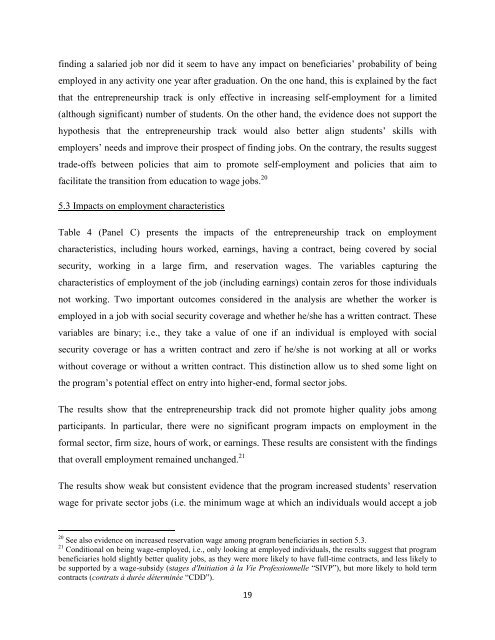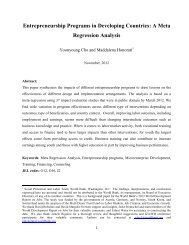Download - Youth Economic Opportunities
Download - Youth Economic Opportunities
Download - Youth Economic Opportunities
Create successful ePaper yourself
Turn your PDF publications into a flip-book with our unique Google optimized e-Paper software.
finding a salaried job nor did it seem to have any impact on beneficiaries’ probability of beingemployed in any activity one year after graduation. On the one hand, this is explained by the factthat the entrepreneurship track is only effective in increasing self-employment for a limited(although significant) number of students. On the other hand, the evidence does not support thehypothesis that the entrepreneurship track would also better align students’ skills withemployers’ needs and improve their prospect of finding jobs. On the contrary, the results suggesttrade-offs between policies that aim to promote self-employment and policies that aim tofacilitate the transition from education to wage jobs. 205.3 Impacts on employment characteristicsTable 4 (Panel C) presents the impacts of the entrepreneurship track on employmentcharacteristics, including hours worked, earnings, having a contract, being covered by socialsecurity, working in a large firm, and reservation wages. The variables capturing thecharacteristics of employment of the job (including earnings) contain zeros for those individualsnot working. Two important outcomes considered in the analysis are whether the worker isemployed in a job with social security coverage and whether he/she has a written contract. Thesevariables are binary; i.e., they take a value of one if an individual is employed with socialsecurity coverage or has a written contract and zero if he/she is not working at all or workswithout coverage or without a written contract. This distinction allow us to shed some light onthe program’s potential effect on entry into higher-end, formal sector jobs.The results show that the entrepreneurship track did not promote higher quality jobs amongparticipants. In particular, there were no significant program impacts on employment in theformal sector, firm size, hours of work, or earnings. These results are consistent with the findingsthat overall employment remained unchanged. 21The results show weak but consistent evidence that the program increased students’ reservationwage for private sector jobs (i.e. the minimum wage at which an individuals would accept a job20 See also evidence on increased reservation wage among program beneficiaries in section 5.3.21 Conditional on being wage-employed, i.e., only looking at employed individuals, the results suggest that programbeneficiaries hold slightly better quality jobs, as they were more likely to have full-time contracts, and less likely tobe supported by a wage-subsidy (stages d'Initiation à la Vie Professionnelle “SIVP”), but more likely to hold termcontracts (contrats à durée déterminée “CDD”).19
















